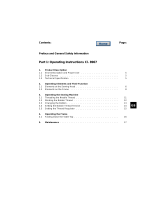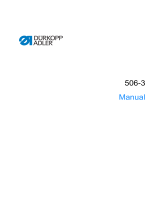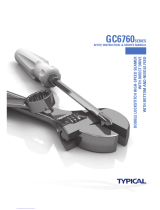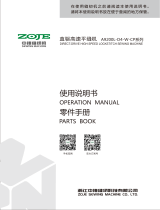Page is loading ...

667
Operating Instructions

All Rights Reserved.
Property of Dürkopp Adler GmbH and copyright protected. Any use of this content, or part thereof, is subject to
prior writ
-ten approval by Dürkopp Adler GmbH.
Copyright © Dürkopp Adler GmbH - 2011

Contents Page
Preface and General Safety Instructions
Part 1: Operating Instructions Class 667 – Original Operating Instructions
(Edition 12/2011)
1 General safety............................................................................................................................................. 1
2 Product description.................................................................................................................................... 3
2.1 Product description ..................................................................................................................................... 3
2.2 Proper Use, Designated use ........................................................................................................................ 3
2.3 Specifications .............................................................................................................................................. 3
2.4 Optional equipment ..................................................................................................................................... 5
3 Operation..................................................................................................................................................... 7
3.1 Threading the needle thread ....................................................................................................................... 7
3.2 Adjusting the needle-thread tension ........................................................................................................... 8
3.2.1 Function of the main thread tension and the supplementary thread tension in relation to the sewing foot
lift for subclass 667-180312 and 667-180322 ............................................................................................. 9
3.2.2 Function of supplementary thread tension in relation to the sewing foot lift and the Speedomat for
subclass 667-180312 and 667-180332........................................................................................................ 10
3.3 Opening the thread tension ......................................................................................................................... 11
3.4 Turning the supplementary thread tension on and off for subclasses 667-180312 and 667-180332 ........ 11
3.5 Adjusting the thread regulator ..................................................................................................................... 12
3.6 Winding on the hook thread ........................................................................................................................ 13
3.7 Changing the hook-thread bobbin .............................................................................................................. 14
3.8 Setting the hook thread tension .................................................................................................................. 15
3.9 Changing the needle ................................................................................................................................... 16
3.10 Lifting the sewing foot ................................................................................................................................. 17
3.11 Locking the sewing feet in an elevated position ......................................................................................... 18
3.12 Sewing foot pressure ................................................................................................................................... 18
3.13 Sewing-foot stroke ...................................................................................................................................... 19
3.14 Adjusting the stitch length ........................................................................................................................... 21
3.15 Key pad on the machine arm ...................................................................................................................... 22
3.16 Sewing with machines using the Efka DC1550/DA321G positioning drive ................................................ 24
4 Maintenance................................................................................................................................................ 27
4.1 Cleaning and inspection .............................................................................................................................. 27
4.2 Oil lubrication ............................................................................................................................................... 29


1 General safety
This instruction manual is intended to help familiarize the user with the
machine and to enable correct utilisation.
The instruction manual contains important information on how to operate the
machine safely, correctly and economically. Observation of the instructions
eliminates danger, reduces costs for repair and downtime, and increases the
reliability and service life of the machine.
The instruction manual is intended to complement existing national accident
prevention and environment protection regulations.
The instruction manual should always be available where the machine/sewing
unit is being used.
The instruction manual must be read and applied by any person authorised
to work on the machine/sewing unit. This means:
Operation, including equipping, troubleshooting during the work cycle,
removing of fabric waste,
– Service (maintenance, inspection, repair) and/or
– Transport
The user must ensure that only authorised persons work with the machine.
The user is required to check the machine at least once per shift for visible
damage and defects, and to report any changes which impair safety
immediately (including operating performance).
The company using the machine must ensure it is only operated in perfect
working order.
As a matter of principle, no safety equipment is to be removed or disabled.
If it is necessary to remove any safety equipment for preparation, repair, or
maintenance work, the safety equipment must be reinstalled immediately
upon completion of said work.
The manufacturer does not assume any liability for damages resulting from
unauthorized modification of the machine.
Observe all of the safety signs and hazard warnings on the machine/unit! The
yellow-and-black striped sections designate permanent hazard areas which
are associated with, for example, risk of crushing, cutting, shearing or
collision.
In addition to the information contained in this instruction manual you should
also observe the applicable general safety and accident prevention
regulations.

General safety precautions
Non-observance of the following safety precautions can result in bodily
injury or damage to the machine.
1. The machine should only be commissioned after reading the associated
operating manual and it should only be operated by persons who have
received the corresponding training.
2. Before starting to use the machine you should also read the safety
precautions specified by the motor manufacturer.
3. The machine should only be used for the purpose intended and with the
safety devices in place. Observe all of the applicable safety regulations.
4. The machine must be disconnected from the power supply by switching
off the master switch or disconnecting the mains plug when exchanging
sewing appliances (such as the needle, sewing foot, needle plate, feed
dog and bobbin), when threading, when leaving the workplace
unattended or when conducting service work.
5. Daily servicing procedures should only be conducted by appropriately
trained persons.
6. Repairs and special maintenance work should only be conducted by
specialist personnel or by persons who have received the corresponding
training.
7. When conducting service or repair work on pneumatic systems the
machine must be disconnected from the compressed air supply (max. 7
- 10 bar). Before disconnecting the machine the maintenance unit is to be
depressurised. An exception to this rule is only permitted for adjustments
and functional checks which are conducted by appropriately trained,
specialist personnel.
8. Work on the electrical equipment should only be conducted by
electricians or appropriately trained personnel.
9. Working on live parts and equipment is not permitted, except as specified
in regulations DIN VDE 0105.
10. Conversions or modifications made to the machine should only be
conducted in compliance with all of the applicable safety regulations.
11. Only those replacement parts approved by us are to be used for repairs.
12. Commissioning of the upper part is prohibited until such time as the entire
sewing unit complies with the provisions of the EC directives.
13. The connecting cable must be equipped with a country-specific mains
plug. The associated work must be conducted by an appropriately trained
specialist (also refer to point 8).
These symbols designate safety
precautions which must be observed at all
times.
Risk of injury!
Please also observe the general safety
precautions.

3
2 Product description
2.1 Product description
The Dürkopp Adler 667 is a special sewing machine for first-class single-
needle decorative seams in light to medium-heavy material.
It is a single-needle flatbed double-backstitch machine with lower
conveyor, needle transport and alternating upper foot conveyor.
A safety coupling prevents the shuttle from being displaced or damaged
if the thread jams in the shuttle track.
Large horizontal shuttle or oversized shuttle.
Automatic wick lubrication with viewing windows for the oil level.
Integrated bobbin winder.
2.2 Proper Use, Designated use
The 667 is a sewing machine designed for sewing light to medium-heavy
material. Such material generally consists of
textile fibres, but can also
include leather. It is used in the clothing industry and for domestic and vehicle
upholstery.
This special sewing machine can also be used to produce so-called technical
seams. In this case, however, the operator must assess the possible dangers
which may arise (with which DÜRKOPP ADLER GmbH would be happy to
assist), since such applications are, on the one hand, relatively unusual and,
on the other, so varied that no single set of criteria can cover them all. The
outcome of this assessment may require appropriate safety measures to be
implemented.
Generally-speaking only dry material should be sewn with this machine. The
material should be no thicker than 10 mm when compressed by the lowered
sewing feet. The material should not contain any hard objects; if it does, the
machine should only be operated with eye protection. No such eye protection
can currently be provided.
The seam is generally produced with textile-fibre sewing thread of gauge up
to 15/3 NeB (cotton), 15/3 Nm (synthetic) or 15/4 Nm (covering yarn). Before
using any other thread the possible dangers arising must be assessed and
appropriate safety measures implemented if necessary.
This special sewing machine should only be set up and operated in dry, well-
maintained premises. If the sewing machine is used in premises which are not
dry and well-maintained,
it may be necessary to implement further precautions (which should be
agreed in advance - see EN 60204-31:1999).
As manufacturers of industrial sewing machines, we proceed on the
assumption that personnel who work with our products will have received
training that is at least sufficient to acquaint them with all of the normal
operations and with any hazards that these may involve.
2.3 Specifications
Noise: Workplace-related emission value in accordance with DIN EN ISO 10821
667 LC = _dB (A)
Stitch length: _ mm, Sewing foot stroke
: ___ mm, Stitch rate: ____ rpm

4
2.3.1 Technical data for subclasses
Subclasses
667-180010
667-180030
667-180112
667-180132
667-180312
667-180332
Type of stitch Backstitch 301
Looper type horizontal, XL large, bobbin Ø 26 mm X X X
Looper type horizontal, XL oversized, bobbin Ø 32 mm X X X
Electromagnetic thread trimmer X X X X
Electropneumatic seam bartacking and sewing foot lift X X X X
Switchable thread tension XX
2 stitch lengths, can be switched electropneumatically X X
2 stroke heights with knee switch, can be switched elec-
tropneumatically
XX
Integrated sewing light XX
Number of needles 1
Needle system 134-35
Max. needle size [Nm] (depending on sewing mechanism) 80-
150
100-
170
80-
150
100-
170
80-
150
100-
170
Max. thread thickness [Nm] 80/3-
15/3
80/3-
10/3
80/3-
15/3
80/3-
10/3
80/3-
15/3
80/3-
10/3
Looper thickness [Nm] 100/
3-20/
3
100/
3-15/
3
100/
3-20/
3
100/
3-15/
3
100/
3-20/
3
100/
3-15/
3
Stitch length forwards/backwards [mm] 9 / 9
Max. stitch rate [rpm] 3000
Speed at factory setting [rpm]
3000
Max. sewing-foot stroke: [mm] 9
Max. height of lifted sewing feet [mm] 20
Operating pressure [bar] 6 6 6 6
Air consumption [NL] 0.7 0.7 0.7 0.7
Dimensions [mm] length / width / height (with attached
Efka DC 1550)
630/ 255/ 420(630/ 290/ 420)
Weight [kg](with attached Efka DC 1550) 50(54)
Rated voltage [V/Hz] depending on motor package
Rated voltage at factory setting [V/Hz] depending on motor package
Power rating [kVA] depending on motor package
2800

5
2.4 Optional equipment
For the sewing machine 667 the following optional equipment is available:
2.5 Stands
Order no. Optional equipment Subclasses
667-180010
667-180030
667-180112
667-180132
667-180312
667-180332
9780 000108 WE-8 maintenance unit for optional pneumatic equipment XXXXXX
0797 003031 Pneumatic connection pack. For connecting stands to the main-
tenance unit
XXXXXX
0867 490010 Control panel angle X X
o
ooo
9822 510003 Halogen sewing light for sewing machine head XXXXXX
9880 867100 Sewing light mounting kit XXXXXX
0798 500088 Sewing light transformer XXXXXX
9880 867103 Diode sewing light (one diode) XXXXXX
9880 867102 Integrated sewing light XXXXoo
9850 001089 Power supply unit for integrated and diode sewing light XXXXoo
9850 867001 PCB for oil monitoring X X o o
0867 590014 Electropneumatic needle cooler, from above XXXX
0687 590984 Mounting kit FK, thread clamp with thread wiper function XXXX
0367 595124 Mechanical sewing foot lift with pedal X X
0687 590364 Pneumatic sewing foot lift (DC 1550) X X
0687 590464 Manual seam tacking o o X X o o
N800 080001Right edge guide, with roller, can be raised XXXXXX
N800 080004 Combined roller and straight guide, right, can be raised, height-
adjustable
XXXXXX
N800 080021Right edge guide, can be raised XXXXXX
N800 080022Guide, for attachment to the base plate XXXXXX
9805 791113 USB memory stick for data transfer with the Efka control unit
DA321G
XXXXXX
Order no.
Subclasses
667-180010
667-180030
667-180112
667-180132
667-180312
667-180332
MG55 400464MG55-3 stand set. Table plate: 1060 x 500 mm with pedal XXXXXX

6

7
3 Operation
3.1 Threading the needle thread
– Place the thread reel on the thread stand and guide the needle
thread through the unwinder arm.
– The unwinder arm must be in a vertical position above the thread
reels.
– Thread in the thread through threading guides 1 and 2.
– Wind the thread clockwise around the pre-tensioner 3.
– Wind the thread counter-clockwise around the supplementary ten-
sioner 4.
– Wind the thread clockwise around the main tensioner 5.
– Pull the thread underneath the thread take-up spring 6 and pass it
through the guide 10 and thread regulator 11, up to the thread lever
12.
– Insert the thread through the thread lever 12 and the threading
guides 9, 8 and 7 on the needle bar.
– Thread the thread into the needle eye.
Caution: Risk of injury!
Switch off the main switch!
The needle thread should only be threaded when the sewing machine is
switched off.
Fig. 1 Fig. 2
1
2
3
4
5
7
8
10
11
6
9
12

8
3.2 Adjusting the needle-thread tension
Fig. 3 Fig. 4
Fig. a: Correct thread interlacing in the centre of the mate-
rial
Fig. b:
Needle-thread tension too strong
or
hook-thread tension too
weak
Fig. c:
Needle-thread tension too strong
or
hook-thread tension too
weak
1
2
3
4
5

9
Pre-tension
When the main tensioner 2 and supplementary tensioner 3 are open the
needle thread must be under slight residual tension. This residual tension is
produced by the pre-tensioner 1.
The pre-tensioner 1 simultaneously affects the length of the end of the
se
vered needle thread (the starting thread for the next seam).
Basic setting:
– T
urn adjusting knob 4 until its front is flush with bolt 5.
Shorter starting thread:
– T
urn adjusting knob 4 clockwise.
Longer starting thread:
– T
urn adjusting knob 4 counter-clockwise.
Main tension
The main tensioner 2 should be set to the minimum possible tension.
The cross-over point of the thread should be in the centre of the material.
When using thin material, excessive thread tension can cause unwanted
ga
thering and thread breakage.
Adjust the main tensioner 2 so that an even stitch pattern is produced.
– I
ncrease tension - turn the adjusting knob clockwise.
– Decrease tension - turn the adjusting knob counter-clockwise.
Supplementary tension
The supplementary tensioner 3 can be switched in to effect a rapid change in
ne
edle-thread tension during operation e.g. with thickened seams.
Set the supplementary tensioner 3 to be lower than the main tensioner 2.
3.2.1 Function of the main thread tension and the supplementary thread tension in rela-
tion to the sewing foot lift for subclass 667-180312 and 667-180322
Button 1 (see chapter 3.15) on the machine's keypad can be used to activate
or deactivate the supplementa
ry thread tension at any time. Parameter F-299
must be set to "1" for this.
1 = Thread tensioner mechanically opened
0 = Thread tensioner me
chanically closed
If the supplementary thread tensioner is open, the status of the sewing foot lift does not change.
If the machine is turned off, the supplementary thread tension remains at its previously set state.
Sewing foot lift in the seam Sewing foot lift afterthread
trimming
Parameter
Setting
Main
th
read
tensioner
Supple-
mentary
th
read
tensioner
Main thread
te
nsioner
Supplemen-
tary thread
tensioner
F-196=0
F-196=1
F-196=2
F-196=3
0
1
0
1
0
1
0
1
0
0
1
1
0
0
1
1

10
3.2.2 Function of supplementary thread tension in relation to the sewing foot lift and the
Speedomat for subclass 667-180312 and 667-180332
Button 1 (see chapter 3.15) on the machine's keypad can be used to activate
or deactivate the supplementary thread tension at any time. Parameter F-255
must
be set to "7" for this to work.
(*) When the max. stroke adjustment is switched on via the knee switch
and the HP-speed of parameter F-117 is reached by the "Speedomat", the
su
pplementary thread tension is switched on automatically.
0 = Supplementary thread tension mechanically closed
1 = Supplementary thread tension mechanically opened
If the supplementary thread tensioner is closed, it remains closed during the stroke adjustment.
If the machine is turned off, the supplementary thread tension remains at its previously set state.
Basic adjustment in the control box for automatic stepwise speed reduction
(Speedomat) by the adjusting knob for the height of the alternating feeding
stroke.
Parameter 188
Step 01-21 entire Speedomat range
Step 01-10 maximum permitted speed, parameterF-111 = 3000 rpm
Step 11-18 linear stepwise reduction of the maximum speed
(
Speedomat)
Step 19-21 maximum permitted speed, parameter F-117 = 1800 rpm
Parameter
Ad
justment
Max. stroke adjustment
via knee switch
Stroke adjusted by the
adjusting knob when
reaching the HP speed
of parameter F-117
(Speedomat)
F-197 = 0
F-197 = 1
F-197 = 2
F-197 = 3
1
0
1 (*)
0
1
1
0
0

11
3.3 Opening the thread tension
Subclasses
667-180010, 667-180030
When lifting the sewing feet with the knee switch, main and supplementary
ten
sion are automatically opened.
Subclasses
667
-180112, 667-180132, 667-180312, 667-180332
The thread tension is automatically opened when trimming the thread.
3.4 Turning the supplementary thread tension on and off for subclasses 667-180312 and
667-180332
Fig. 5
The supplementary tension can be switched on and off with lever 1.
Switching on
– Pus
h the handle 2 of lever 1 to the left.
Switching off
– Pu
sh the handle 2 of lever 1 to the right.
1
2

12
3.5 Adjusting the thread regulator
Fig. 6
The thread regulator 1 controls the quantity of needle thread required for
s
titch formation. The thread regulator must be precisely adjusted for an
optimum result.
With correct setting the needle-thread loop must slide with low tension over
t
he thickest point of the hook.
– Lo
osen screw 2.
– Adjust the position of thread regulator 1: thread regulator to the left
= more thread; thread regulator to the right = less thread
– Tighten screw 2.
Adjustment information:
If the maximum quantity of thread is required, the thread-tensioning spring 3
must
be pulled upwards approx. 0.5 mm from its lower limit position. This is
the case when the needle-thread loop passes the maximum hook diameter.
Caution: Risk of injury!
Switch off the main switch.
The thread regulator may only be adjusted with the sewing machine switched
off.
1
3
2

13
3.6 Winding on the hook thread
– Put the thread reel on the thread stand and lead the hook thread
through the unwinder arm.
– Pull the thread through guide 5, tensioner 3 and guide 4.
– Place the thread behind the blade 6 and sever it.
– Insert the bobbin 1 onto the bobbin winder. There is no need to
wind the thread onto the bobbin by hand.
– Press the bobbin-winder lever 2 into the bobbin.
– Start sewing. The bobbin winder lever terminates the process as
soon as the bobbin is full. The bobbin winder always stops in such
a way that the blade 6 is in position.
– Remove the full bobbin 1, place the thread behind the blade 6 and
sever it.
– Fit an empty bobbin onto the bobbin winder for the next winding
process and press the bobbin-winder lever 2 into the bobbin.
Fig. 7 Fig. 8
CAUTION: Risk of breakage!
If the thread is not to be wound on during sewing, the sewing foot must be
locked in an elevated position and the sewing-foot stroke set to the smallest
value.
2
1
5
3
4
2
6

14
3.7 Changing the hook-thread bobbin
Fig. 9
Remove the empty bobbin.
– Set the needle bar at an elevated position.
– Lift the bobbin case flap 2.
– Remove the bobbin case 3 with bobbin 6.
– Remove the empty bobbin from the bobbin case 3.
Insert a full bobbin.
– In
sert a full bobbin into the bobbin case 3.
– Observe the direction of rotation of the bobbin.
– The direction of rotation is correct when the bobbin rotates in an
opposite direction to the drawing direction of the thread.
– Pull the hook thread through the slit 5 underneath the tension
spring 4 into the hole 7.
– Pull approx. 5 cm of hook thread from the bobbin case 3.
– When pulling the thread, the bobbin should turn into the direction
indicated by the arrow.
– Reinsert the bobbin case 3.
– Close the bobbin case flap 2.
Caution: Risk of injury!
Switch off the main switch.
The hook-thread bobbin may only be changed with the machine switched
off.
CAUTION: Risk of breakage!
Press down firmly on the bobbin case and make sure it engages correctly.
2
1
3
4
5
6
7
2

15
3.8 Setting the hook thread tension
Fig. 10
Brake spring
The brake spring 1 is responsible for preventing a bobbin overrun when the
m
achine stops and when the hook thread is being cut. It cannot be adjusted!
Setting the tension spring
– Adjust the tension spring 4 with the adjustment screw 3. Turn until
the required tension force is present.
Increasing the hook thread tension
– Turn screw 3 clockwise.
Decreasing the hook thread tension
– T
urn screw 3 counter-clockwise.
Caution: Risk of injury!
Switch off the main switch.
The hook-thread tension may only be adjusted with the sewing machine
switched off.
4
3
2
1

16
3.9 Changing the needle
– Turn the handwheel until the needle bar 1 reaches its highest posi-
tion.
– Loosen screw 2.
– Pull the needle downwards out of the needle bar 1.
– Insert the new needle into the hole of the needle bar 1 and push it
until it stops.
CAUTION!
The needle scarf 3 must be pointing towards the hook.
– Tighten screw 2.
CAUTION!
After changing to a needle with a different thickness the
clearance gap between the hook and the needle must be adjusted
(see service instructions).
Non-compliance with this information can result in the following
errors: Changing to a thinner needle:
missing stitches
thread damage
Changing to a thicker needle:
damage to the hook tip
damage to the needle
Fig. 11 Fig. 12
Caution: Risk of injury!
Switch off the main switch.
The needle may only be changed with the sewing machine switched off.
2
1
3
2
3
/










